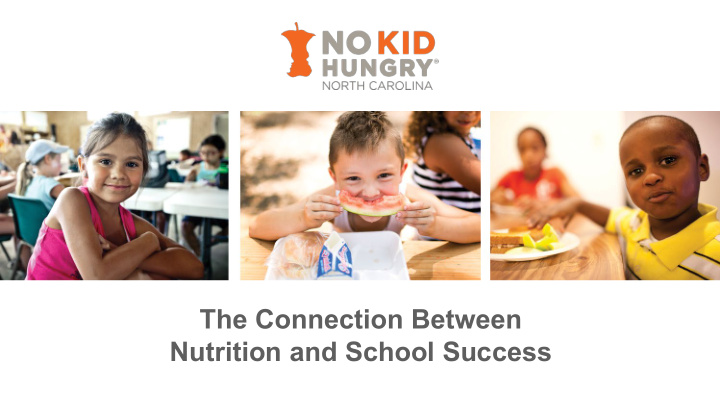



The Connection Between Nutrition and School Success
No Kid Hungry No Kid Hungry is a national campaign launched by the non-profit Share Our Strength in 2010. Its goal is to end child hunger in the United States. No Kid Hungry North Carolina The NC campaign was formed in the Office of the Governor in 2011. No Kid Hungry NC becomes an initiative of the UNC-Chapel Hill Center for Health Promotion and Disease Prevention in 2014. The focus of No Kid Hungry NC is promoting and increasing participation in federally-funded nutrition programs, including school breakfast, summer meals, and afterschool meals. NoKidHungryNC.org • @NoKidHungryNC
When it comes to hungry kids, there is a big need in North Carolina. Almost 900,000 students in NC’s traditional public schools are eligible for Free or Reduced-Price (FRP) school meals. That’s nearly 60 percent of NC’s almost 1.5 million public school students. NoKidHungryNC.org • @NoKidHungryNC
North Carolina: 115 public school districts Almost 2,500 public schools Virtually all participate in the school breakfast program 1.5 million public school students Nearly 60 percent – or almost 900,000 – public school students qualify for free or reduced price school meals NoKidHungryNC.org • @NoKidHungryNC
There is a huge BREAKFAST GAP between the number of: FRP-eligible students who eat FRP-eligible students who eat and school lunch school breakfast Only 58% of FRP-eligible children — who often depend on school for their nutrition — eat both school lunch and school breakfast. NoKidHungryNC.org • @NoKidHungryNC NoKidHungryNC.org • @NoKidHungryNC
251,000 students statewide in the Breakfast Gap That’s 251,000 students who: 1) Qualify for Free or Reduced-price school meals. 2) Eat school lunch. 3) But DON’T eat school breakfast. NoKidHungryNC.org • @NoKidHungryNC NoKidHungryNC.org • @NoKidHungryNC
Breakfast is already served in school. So what barriers are keeping students from eating it? Time Traditional breakfast in the cafeteria is served before school begins. Students often have to make a choice between getting to class on time and eating. Place Traditional breakfast in the cafeteria keeps students from heading straight into the learning environment, and requires supervision by instructors, pulling everyone out of the classroom. Stigma Students may face shaming or embarrassment for eating school meals, especially if they receive them for a free or reduced price. NoKidHungryNC.org • @NoKidHungryNC
To close the gap and overcome these barriers, we need modern, innovative methods of serving school breakfast. They are collectively known as Breakfast After the Bell and include: • Breakfast in the Classroom • Grab and Go • Second Chance Breakfast These models lead to 70% to 90% participation on average in school breakfast. NoKidHungryNC.org • @NoKidHungryNC
The best way to increase access to the school breakfast program is to make it part of the school day. Average Participation in School Breakfast By Model of Delivery: Breakfast in the Classroom (BIC) • Breakfast is served and consumed in the classroom Second Chance Breakfast • Meals are served after first period • Allow kids to eat in class Grab and Go to the Classroom • Meals served in convenient, easy to access locations before and after the bell • Allow kids to eat in class Traditional Cafeteria NoKidHungryNC.org • @NoKidHungryNC
“Kids need to know that they’re safe, they’re loved, and they’re gonna be supported. That means being fed… I can’t see academic increases if my students are hungry.” – Principal Thyais Maxwell, formerly at Hampton Elementary University Partnership Magnet in Guilford County Maslow’s Needs NoKidHungryNC.org • @NoKidHungryNC
The impact of students eating a healthy school breakfast includes: Increased ability to focus. Fewer behavior problems. Better attendance and less tardiness. Improved academic performance. NoKidHungryNC.org • @NoKidHungryNC
Teachers see access to breakfast as an education issue. Equity NoKidHungryNC.org • @NoKidHungryNC
Remember: there is a huge BREAKFAST GAP between the number of: FRP-eligible students who eat FRP-eligible students who eat and school lunch school breakfast Currently, the breakfast gap statewide is 59% filled. Further filling it to reach just 70% would mean almost $2.5 million in additional federal funds brought in annually to North Carolina, directly to school districts. That’s an average of about $213,000 per district. Source: FRAC North Carolina School Breakfast Report, 2016-2017 School Year, March 2018 NoKidHungryNC.org • @NoKidHungryNC
Beginning a new Breakfast After the Bell program costs about $0 to $5,000 on average, plus buy-in and enthusiasm from administrators, staff, and educators. NoKidHungryNC.org • @NoKidHungryNC
What can Teachers of the Year do? If your school or district is already using Breakfast After the Bell method to serve more kids, share the story of that program's success with other teachers and encourage them to adopt similar programs. If your school still has a big need when it comes to breakfast participation, approach your principal or leadership team to raise the idea of making a change to how breakfast is served in order to feed more kids and improve school climate. Start at NoKidHungryNC.org/TOY where you can find data on your school, district, or region, as well as other helpful resources. NoKidHungryNC.org • @NoKidHungryNC
No Kid Hungry NC is a resource: NoKidHungryNC.org/TOY Julie Pittman Educator Programming Manager No Kid Hungry NoKidHungryNC@gmail.com twinologist@gmail.com Questions? NoKidHungryNC.org • @NoKidHungryNC
THANK YOU NoKidHungryNC.org/TOY NoKidHungryNC.org • @NoKidHungryNC
Recommend
More recommend